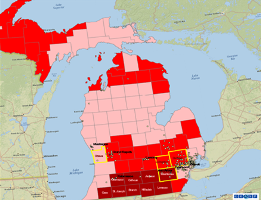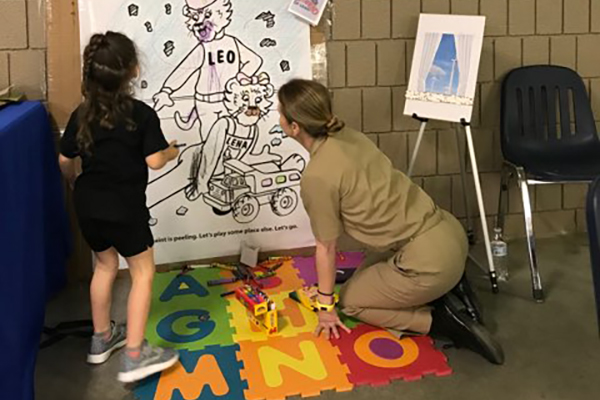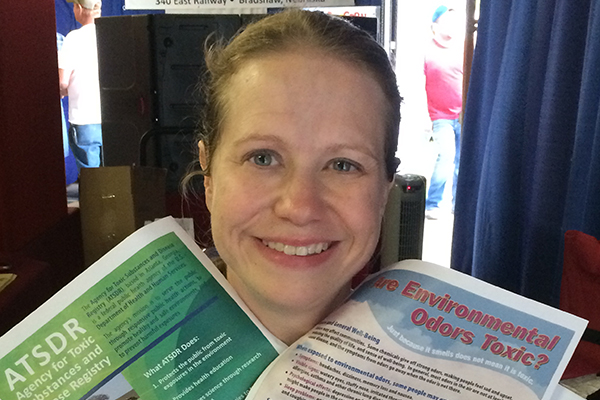Community Engagement Actions, Tools, and Activities
This section will familiarize you with frequently used community engagement tools and activities.
There are many actions, tools, and activities available to facilitate community engagement during the PHA process. Not all of these actions, tools, or activities will be used at every site. Choose those that are appropriate for the phase of the process, the level of community interest, and the degree of hazard a site poses.
The table below shows a variety of community engagement actions that you could implement at a site during various phases of the PHA process depending on site-specific issues and health concerns. The table shows examples of some community engagement activities that may be conducted at sites. Site teams can choose different activities based on the needs of each particular site community.
Possible Community Engagement Actions at Each Phase of Community Engagement
| Phase | Possible Community Engagement Actions |
|---|---|
| 1. Setting the Stage
|
|
| 2. Getting Started
|
|
| 3. Keeping it Going
|
|
| 4. Wrapping Up
|
|
Online tools can be helpful early in the process to obtain information about the community’s characteristics and demographics. For example, GIS maps can assist in identifying populations near the site and populations that might be susceptible to site contamination. In some cases, social characterization maps can be generated to help anticipate various characteristics of the population and to prompt the team to ask appropriate questions during the site visit.
Community Information
Community members can provide valuable information about the site, general health issues in the community, languages spoken, and other useful information. Some may already be involved, or willing to participate, in Citizen Science efforts. Citizen science encourages members of the public to voluntarily participate in the scientific process by asking questions, making observations, or collecting data.

Geospatial Research, Analysis, and Services Program (GRASP) can help health assessors use geospatial tools to gather valuable information about a community.
More
Community Meetings
Community meetings are critical to the success of the PHA process and can be held at different junctures during the PHA process. The format you choose depends on the purpose of the meeting and the information needs and preferences of the site community. Meeting formats include:
- Informal discussions. Community members can often provide valuable information during the PHA process. For instance, this information could be about the potential for current or past exposures at or near a site, such as the locations of children’s play areas or local “swimming holes,” or historic information about sites that are not captured in government reports. These one-on-one meetings with community members represent different groups and perspectives. Conversations can be conducted in person, by telephone, or by video conference. During the PHA process collecting feedback from the public is necessary. ATSDR employees are bound by the Paperwork Reduction Act. This law requires Federal agencies to
- seek public comment on proposed information collections and
- obtain approval from the Office of Management and Budget (OMB) before collecting information from more than nine members of the public.
Some helpful resources on this topic include CDC’s Paperwork Reduction Act Compliance website and CDC’s “What You Need to Know About the Paperwork Reduction Act” video.
Community Knowledge Is Valuable
Communities can share information valuable to the PHA process, such as:
- Health concerns and risk perceptions about the site.
- Perceptions toward ATSDR and other involved organizations.
- Information on regular community activities (including sports events or festivals).
- Languages spoken.
- Community’s historical events.
- Information sources and stakeholders to involve in the PHA process.
- Ways they prefer to receive information.
- Trusted sources of health information.
- Locations where the community usually receives health care services.

While reviewing historical environmental data at a closed landfill site, a health assessor noted elevated (above background) levels of cadmium, lead, and other metals in a small pond across the road from the site. The pond had no known drainage connection to the landfill.
In discussing the landfill with residents, the health assessor learned that during high rainfall events, storm water would flow from the landfill, across their yards and the road, and into the pond. Residents reported storm water depositing mud and other debris in their yards and the street.
As a result of this information, the health assessor connected the contamination of the pond to the landfill, identified an exposure point that might not have otherwise been evaluated, and recommended surface soil sampling of the affected residential yards.
- Virtual meetings. Virtual meetings allow ATSDR to present information to community members and respond to questions without needing to travel to the community. They can be set up on a variety of virtual platforms.
- Public availability sessions. An informal meeting where community members can talk confidentially one-on-one with ATSDR about their health- and site-related concerns. The health concerns gathered at this session help direct the PHA process.
- Poster sessions. Gatherings where ATSDR meets with small groups of community members to discuss information displayed on posters. Consider themes for the poster session, such as “ATSDR and the PHA process.” During these sessions, ATSDR staff can give informal presentations, answer questions, and discuss concerns with the public. Representatives from other agencies may also display information and discuss their agencies’ work at the site.
- Public meetings. ATSDR and (possibly) representatives from other agencies meet with community members to share information about the PHA process and the findings of the site-specific evaluations. Develop an agenda prior to the meeting with community member input whenever possible and include a question and answer period. When planning meetings, be sure to follow the Community Meeting Guidelines [PDF – 70.4 KB] from the ATSDR Communication Toolkit.
- Other meetings. Other types of meetings can be held in response to specific community needs or environmental issues. These may include meetings of community groups or local officials, workgroups formed to address a particular issue, or workshops conducted to provide technical or educational information to communities.
- Combined approaches. A combination of different meeting approaches can also be used. For instance, community members could attend a poster session as they wait to talk to an ATSDR representative during a public availability meeting. You could also host a poster session after a large public meeting so that people have a chance to learn more about the site and engage one-on-one with ATSDR.

CDC/Dawn Arlotta; photographer: Cade Martin
ATSDR has developed helpful guidelines [PDF - 70.4 KB] to help ensure successful public meetings.
Site teams need to share information with the community in a timely manner throughout the PHA process, and fact sheets are frequently used for this purpose. ATSDR has many general fact sheets available about its mission and work that can be distributed, and also develops site-specific fact sheets and flyers.
ATSDR Fact Sheets Available
Many general fact sheets are available from ATSDR’s Online Fact Sheet Repository. When requesting fact sheets, allow enough time so that copies can be printed if necessary.
Example fact sheets are also available from ATSDR’s Guide to Materials Development [PDF – 101 KB] in the ATSDR Communication Toolkit.
Site teams need to share information with the community in a timely manner throughout the PHA process, and fact sheets are frequently used for this purpose. ATSDR has many general fact sheets available about its mission and work that can be distributed, and also develops site-specific fact sheets and flyers.
Site-specific fact sheets (such as the Asarco [PDF – 1,811 KB], Pease International Tradeport [PDF – 1,011 KB], and Valley School [PDF – 1,061 KB] examples) briefly introduce ATSDR, summarize the information that ATSDR currently knows about the site, and describe ATSDR’s current and future plans for the PHA process, including plans to meet with the community. You can also use site-specific fact sheets to announce the availability of a report or to familiarize recipients with information prior to, during, or in between community meetings. Work with a health communication specialist when planning for and developing fact sheets. Distribute them via electronic mail, postal delivery, on the ATSDR website, or during a community meeting.
Flyers are one-page or postcard meeting announcements distributed to community members and other stakeholders to notify them about a meeting. The flyers contain information about the type of meeting and the agenda, meeting location, date, time, and any other background information that might be helpful and serve to encourage the recipient to attend. Be sure to include contact information for site team members as well as ATSDR’s toll-free number.
Community members or other stakeholders can assist in door-to-door distribution or by leaving the fact sheets or flyers in public locations, such as libraries, post offices, or grocery stores.
Websites
In some cases, you may choose to establish a site-specific website (for instance, see the Coldwater Creek and Camp Lejeune examples) to disseminate and even collect site information. This method may be considered based on different site-specific reasons, such as if it is recommended by the community or you know the majority of community members would use this as their source to obtain site information. If appropriate, a website can be a convenient mechanism for storing and sharing information. All websites will need to comply with Section 508 accessibility requirements, as explained in Section 508 of the Rehabilitation Act of 1973.
Social Media
ATSDR uses various types of social media tools to spread messages about sites to communities and other interested stakeholders. Health assessors can use the agency’s @CDCEnvironment Twitter account to spread public health messages to its target audiences. Work with a health communication specialist when preparing your messages and using social media for your sites.
ATSDR can also use CDC’s social media platforms to post information. Some examples of available platforms are as follows:
- Twitter (@CDC_EPHTracking and @CDCasthma)
- YouTube
- Environment Blog
Site teams also have access to various Environmental Health Multimedia Tools, such as mobile apps, widgets, and videos. Be sure to adhere to the agency’s social media policies when using these social networks. Refer to CDC’s Guide to Writing for Social Media and The Health Communicator’s Social Media Toolkit.
The media, including local newspapers, radio, and television stations, are an important communication resource. ATSDR’s need for timely, cost-effective distribution of information to the public often complements the media’s need for content to publish or broadcast. During the process of engaging with media outlets, be sure to consult with a health communication specialist who can assist with developing talking points, seeking agency approval, and sharing them with the media. ATSDR can provide information to the media by issuing press releases, holding media sessions during public meetings or elsewhere, or providing or requesting interviews. The agency sometimes issues a public service announcement. In all these situations, ATSDR cannot be sure if or when the information will be disseminated or what the media will specifically report. Occasionally, ATSDR pays for advertising, which enables the agency to control what information is disseminated to the public and when.
Public Notifications
There are many options for public notification about upcoming ATSDR meetings, public comment document availability, and final report (e.g., PHA, HC) releases. ATSDR can notify people using techniques such as social media postings, news releases, or website postings. ATSDR also provides other types of information to the media on a site-by-site basis, as needed. Search for press releases and other media announcements the agency has released over time at the ATSDR Press Room website.
During the initial stages of the PHA process, ATSDR establishes information repositories at convenient locations (e.g., public libraries) within the community. These repositories will house copies of important site-related documents. At many sites, the repository is co-located with EPA’s, the tribe’s, or the state’s information repository. The distribution channels described above can be used to publicize the existence and location of the information repositories. Information repositories are important to ensure equitable access of information to all community members who want to review ATSDR’s materials – regardless of whether they have computer access or not.
ATSDR Toll-Free Hotline
Be sure to make residents aware of ATSDR’s toll-free hotline (1-800-CDC-INFO) and ATSDR’s website for accessing information.
Mailing Lists
You can create an email or postal mailing list of interested community members by gathering addresses at community meetings or by working with community groups. Examples of other sources for mailing lists include local utilities, county tax maps, community group membership lists, and mailing lists created by community members through neighborhood surveys. If you are working with a community that prefers receiving information through email, then creating a distribution list with recipient email addresses might be appropriate for your site.
Other Activities Generated As Part of the PHA Process
In addition to community engagement activities that are directly related to the PHA process (e.g., a community meeting where ATSDR discusses the findings of a PHA), ATSDR has developed some activities and materials to engage communities around specific environmental health topics. Some examples include:
- Brownfields and Land Reuse: Through its Land Reuse Health Program, ATSDR actively engages with communities to foster and support land revitalization activities, referred to as brownfield and land reuse sites (see box on the right for definitions). These initiatives focus on redeveloping sites that may be contaminated with chemicals from past or current uses. Community engagement is integral to this program, which promotes health, community involvement, partnerships, communication, and education. This program is a way for communities to incorporate health considerations in land reuse decisions. ATSDR works with the EPA, state and local officials, developers, and communities to include health in these types of projects. Through this redevelopment process, vacant or under-used land can be turned into places that benefit the entire area, such as schools, parks, and gardens. ATSDR works directly with community members to answer their questions, provide tools and resources, and connect communities with funding opportunities.
What is a Brownfield or Land Reuse Site?
In 2002, Congress amended CERCLA to include a formal definition for a brownfield site. Under this definition, the term means real property, the expansion, redevelopment, or reuse of which may be complicated by the presence or potential presence of a hazardous substance, pollutant, or contaminant. There are some exclusions to the definition, such as facilities that may be placed or are listed on the National Priorities List (i.e., Superfund sites).
ATSDR includes brownfields as a type of land reuse site. Land reuse sites are sites slated for redevelopment but may have contamination. Land reuse sites include brownfields plus those sites that are exempted from the 2002 CERCLA amendment, such as Superfund sites.
- Don’t Mess with Mercury: ATSDR has developed various outreach materials to help prevent mercury spills at schools as part of its Don’t Mess with Mercury campaign. Examples of these ATSDR products include a public service announcement, educational videos, fact sheets, modules on the dangers in mercury in schools, and modules on mercury spill cleanup.
- Choose Safe Places for Early Care and Education: ATSDR created the Choose Safe Places program to encourage careful consideration about where to locate early care and education (ECE) sites. Choose Safe Places gives towns, cities, and states a framework to adopt practices that will make sure ECE programs are located away from chemical hazards. ATSDR also provides technical support and guidance to help states start their own Choose Safe Places program. ATSDR has various tools for states and communities to use, as well as a listing of available resources and publications related to the program for those seeking more information.
- soilSHOP: ATSDR promotes lead health education and outreach events called “soilSHOPs,” which stands for Soil Screening, Health, Outreach and Partnership. The purpose is to help people learn if their soil is contaminated with lead or other heavy metals, and how to reduce exposures to contaminated soil and produce. ATSDR developed a soilSHOP Toolkit to help communities and other groups plan their own soilSHOP events.



The Principles of Community Engagement describes the role of social networks in community health and provides suggestions for using them effectively.
CDC’s Guide to Writing for Social Media provides tactical advice for encouraging action, engagement, and interaction using Facebook, Twitter, and text messaging.



